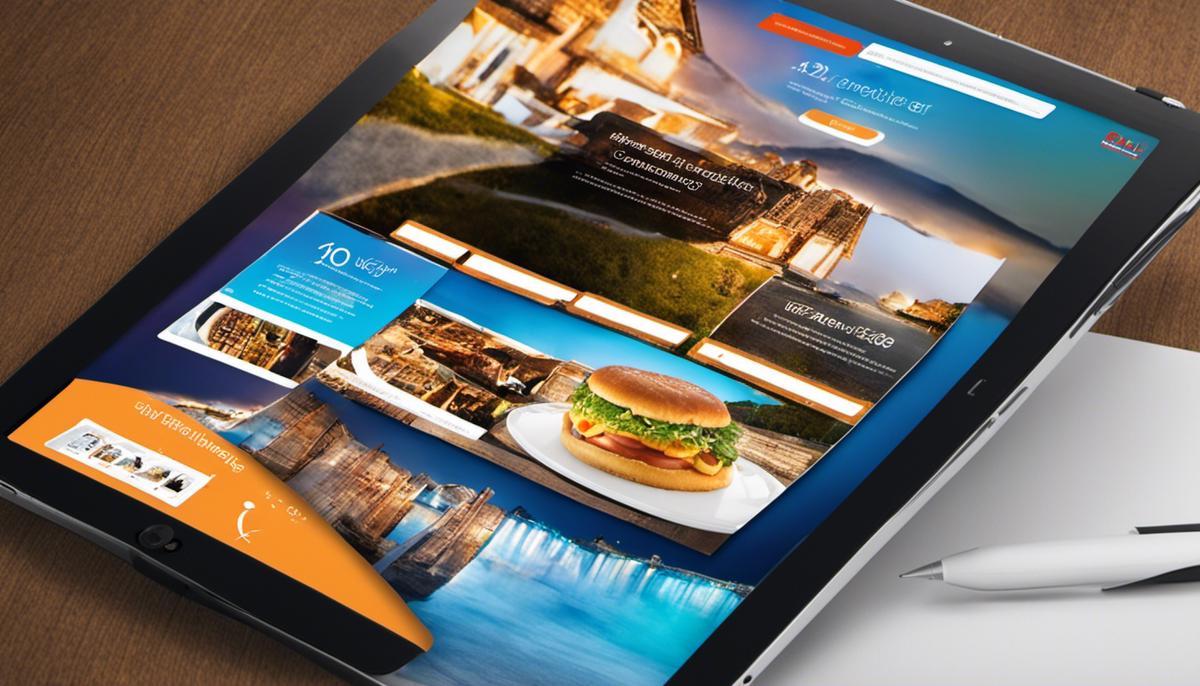In an ever-evolving digital landscape, staying ahead of competition requires creative and innovative approaches to engage potential customers. One such powerful tool that has shown to deliver impressive results is the use of interactive images on landing pages. A carefully designed, strategically placed interactive image can grab the attention of site visitors, providing a user-friendly experience that will not only keep them engaged but encourage them to take the desired action. This essay delves into the significance of interactive images, how to create and utilize them to their maximum impact, and the importance of continuous testing and optimization for best conversion results.
Understanding the Importance of Interactive Images
Interactive Images: The Secret Ingredient for High-Converting Landing Pages
Powerful visuals stimulate and engage users more than extensive text. In fact, they have the potential to boost conversion rates. This statement shouldn’t come as a surprise to most people. After all, we’re living in a digital age where graphics, videos, and images have become a crucial part of everyday communication. One of the most successful innovations in the arena of visual content is interactive images, which are redefining the game in landing page design.
While every savvy business owner knows the importance of visuals on a landing page, what separates the innovators is the understanding and application of interactive images. This is a game-changer that takes landing page optimization to a new level.
- Creating User Engagement
- Providing In-depth Information
- Encouraging a Seamless Journey
- Enabling Personalized Interaction
- Boosting SEO Rankings
The first benefit provided by interactive images is enhanced engagement. Rather than just staring at static images, users can actively engage with images that offer drop-down menus, clickable points, or animation upon hovering over them. Studies reveal that this active involvement significantly increases user engagement, leading to more time spent on the page, and ultimately, higher conversion rates.
Anticipate your prospects’ queries and answer them through interactive images. Detailed visuals can help break down complex features, products, or services in a digestible format. A well-executed interactive image can do the job of explaining your business offerings effectively, without the need for lengthy descriptions, which could potentially bore your customers.
Interactive images are an excellent tool for guiding prospects through their buyer’s journey. For instance, a photo of your product could have clickable spots that lead to more detailed explanations, or even to a direct purchase link. This functionality encourages users to further explore the product or service, providing a seamless route from curiosity to conversion.
Thanks to advancements in programming and design, interactive images can offer personalized encounters based on user behavior. For instance, offering different content to new visitors versus returning visitors. This increased personalization can improve user experience and, therefore, conversion rates.
Search engines now prioritize engagement metrics, such as bounce rate and time spent on a page, when determining SEO rankings. By implementing interactive images and achieving greater user engagement, you can directly improve your site’s SEO performance. Better rankings equate to more website traffic and increased opportunities for conversions.
Finally, harness the power of analytics that come along with these interactive elements. Keep track of what works and what doesn’t. Test, tweak, and repeat. Regardless of which industry you’re operating in, leveraging the power of interactive images can be a game-changing strategy in creating high-converting landing pages. Remember, it’s not just about visual appeal; it’s about creating a result-oriented user experience. Settle for nothing less.

Creating and Utilizing Effective Interactive Images
Constructing Interactive Images for Landing Pages: Tools, Techniques, and Tips
In the digital marketing universe, visuals are the powerful business tools that transform lead pipelines into active transactions. Interactive images have emerged as a dynamic player in the online landscape, revolutionizing the league of engaging visuals. They offer an innovative take on delivering to your audience a distinctive blend of information, engagement, and personalized interaction.
Diving into the practical application of this concept, how can businesses design and implement effective interactive images on their landing pages?
Unleashing the potential of such interactive images, involves specific software tools, a sense of creative vision, and an understanding of your target audience’s needs. Start by selecting an optimal software platform that aligns with your objectives. From Adobe XD, Marvel, and Sketch to Canva, each software platform harbors unique features that cater to different interactive designing needs. Research, compare, and choose alignments diligently to obtain a platform that best caters to your business need.
Designing an interactive image is a meticulous process. Keep in mind both the representation and information value to make the piece worthwhile. Balance creativity and utility in all designs. At the crux of a successful interactive image, is an innovative concept that will communicate effectively without overwhelming visitors. Useful cues, such as arrows, buttons, or hover effects, can guide the user interaction and make the experience intuitive. When utilized properly, these cues subtly stimulate desired user actions and aid in decision-making.
And what is innovation without personalization? Mesh the functional aspects of the design with the aesthetic elements that resonate with your audience. Run preference analysis on your consumer base and implement the insights into designs. Color psychology, typography and the use of white space can contribute significantly in creating visually dominant designs that visually stimulate and provoke click actions.
However, to ensure effectiveness, remember to indulge in rigorous testing. A/B testing lets you compare the performances of different versions, allowing you to gauge what works best with your audience. The information gleaned from this testing phase is crucial in making informed decisions on which designs or interactive elements to retain, refine, or discard.
Plan a cross-platform compatibility check as well. It ensures your designs are responsive, functional, and consistently presented across different devices.
In the larger scope, the integration of interactive images on your landing page is not a standalone activity. Maintain congruity with your brand image, content strategy and overall website design. The elements should seamlessly blend, creating a coherent and engaging narrative that guides the visitor through the customer journey.
Always remember, every click is a conversation. The more engaging, enriching, and seamless this conversation is, the more conversions you ensure. Bringing interactive images into play thus demands more than just design aesthetics, it requires strategic precision, innovative thinking, and insightful understanding of your target market. So dive in, experiment, and drive engagement through effective, interactive visuals on your landing page.

Photo by taisiia_shestopal on Unsplash
Testing and Optimizing Interactive Images
Delving into the specifics,
it’s crucial to ensure your interactive images are chock-full of data-rich hotspots. When users hover or click on such hotspots, additional relevant information should unfold, adding depth and context to the main image. With this approach, you cater to the user’s curiosity without overwhelming them with a flood of details.
As a business-savvy entrepreneur, you understand the value of time – your audience’s time. Make sure interaction with your images is easy and intuitive. Tools like tooltips, zoom-in features, and simple navigation can make the user experience smooth and enjoyable, helping to keep potential customers engaged and open to conversion.
Leverage storytelling with interactive images, creating unique narratives that will captivate your audience and stick in their minds. This can be done through sequenced images or through interactive image maps. By doing so, you are captivating your audience, making them more likely to share the experience and thus, amplifying your reach.
Tight cohesion between the textual, auditory, and visual elements should always be top priority. This essentially means that all aspects of your website’s content must align with your interactive image and vice versa. A curveball thrown in the form of an out-of-place image can disorient users and dent conversion rates.
In an age where mobile devices reign supreme, it would be a catastrophic mistake to ignore mobile optimization. Make sure your interactive images are responsive, ensuring they display correctly on all screen sizes and devices. Blurry or pixelated images will cause users to bounce, making mobile optimization paramount for keeping potential leads on your site.
Lastly, remember that diversity is the name of the game. Mix up your media and use various types of interactive content: sliders, quizzes, calculators, or even virtual tours. This assortment can transform the user’s journey into a lively, engaging adventure, significantly boosting conversion rates.
In conclusion, optimizing interactive images is not just about installing a few trendy visual components on your landing page. It is an ongoing quest for seamless integration into your online strategy, focusing on enhancing user experience while aligning with your overall business goals. Hold these principles firmly in your playbook, and you’ll master the art of optimizing interactive images to maximize conversion rates.

The importance of interactive images on high conversion landing pages cannot be overstated. Through a combination of creativity, strategic positioning, and efficient optimization, interactive images can significantly enhance the user experience and maximize conversion rates. Continuous testing and optimization provide the added insight needed to adjust and adapt to changing user behaviors and expectations. Armed with these tools and techniques, you can transform your landing pages into dynamic, engaging destinations that convert casual visitors into loyal customers.

